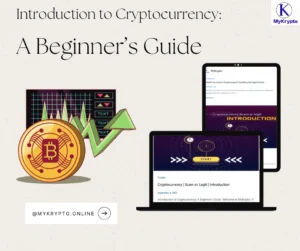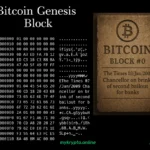Introduction to Cryptocurrency: A Beginner’s Guide
Welcome to MyKrypto! If you’ve come here to learn about cryptocurrency, you are in the right place. Even if you’re starting from zero, don’t worry, I will guide you step by step until you feel confident and knowledgeable. Sounds good? Yeah.
This is a beginner-friendly article, and in this article, we will walk through the basics of cryptocurrency in the simplest way possible. Really, I am not kidding. Ha ha. By the end, you’ll clearly understand what cryptocurrency is, how it works, why it matters, and what you should know before getting started.
Shall we begin our crypto journey? Hmm, great, here we go.

See, in recent years, the word cryptocurrency has become one of the most trendy terms, especially when you look around everywhere
You may have heard people say, “I made a lot of profit with Bitcoin.” You might have read headlines about governments trying to regulate cryptocurrency. Why are so many people interested in it? And should you care about it too? But before that, you need to understand exactly what the word crypto means.
So, let’s get started.
What is Cryptocurrency?
Cryptocurrency is simply a digital money or currency. Your physical currencies, like coins and notes, you can touch them, feel them, see them, and you put them in your wallet. But dear, cryptocurrency does not exist physically; instead, it exists digitally or in electronic form. Make sense?
You might have thought, “It should be more than just digital versions of traditional money, and it is considered an asset?” Exactly, you are absolutely right.
“But why fancy name crypto, why can’t it be simply digital currency?” Are you wondering about this? Then you are going in the right direction. Let me explain you in a simple way.
Crypto:
The term “crypto” came from cryptography, which is the science of secure communication.
Digital currency:
Any money that exists in electronic form, as you can see the balance in your bank account, Paytm, etc, is your digital currency. But are they controlled by someone? Yes, you are right. They are still controlled by banks and governments.
Cryptocurrency: A special kind of digital currency that uses cryptography, and guess who controls it? Any idea? Listen, they are controlled by blockchain technology.
Now, what is Blockchain, brother? Hmm. To explain this, suppose you write something on a paper and make thousands of xerox copies and don’t keep it with you, distribute it to others. Now tell me, if one day you deny the same thing that you have written, is it possible? The Xerox copy you have distributed is called a block in the digital world, and it forms a chain. Even if you edit in your paper, it can’t be changed everywhere. That is called blockchain technology, and that is what makes it unique.
A blockchain is can be considered as a public digital notebook that records each and every transaction. Once something is written in this notebook, it cannot be erased or changed by any means. This makes it secure, transparent, and trustworthy.
There are many cryptocurrencies, but the most famous cryptocurrency is Bitcoin, created in 2009 by a mysterious person or group known as Satoshi Nakamoto. Brother, we don’t even sure about his name. Since then, hundreds of other cryptocurrencies like Ethereum, S-Coin, and Litecoin etc have been created. You can also make your own. “Wowwww”, but hey, this is another fish to fry, we will open this front in some other blog.
Congratulations, now you are well aware of the name and have a little bit of an idea about it.
How is Cryptocurrency Different from Regular Money?
I am pretty much sure that now you have a good idea about how cryptocurrency is different from regular money, but you need to know more about it. Here are a few key differences:
Decentralization
- Regular money is issued and controlled by governments and banks.
- Cryptocurrency is not controlled by any single authority. Instead, it runs on a computer network worldwide. Now you tell me that technology. It is obvious a blockchain technology. Sounds good.
Global Access
- With crypto, you can send money to anyone, anywhere, without worrying about banks or international fees.
- A farmer in India can send money to a student in the USA instantly. Hehe, just an example, don’t take it personally.
Transparency
- Every Crypto transaction is recorded on the blockchain, which is open for anyone to see. This makes it hard to cheat the system. Hmm, cool, right?
Limited Supply
- Some cryptocurrencies, like Bitcoin, have a fixed limit. There are around 21 million Bitcoins exist today. This is very different from paper money, which governments can print as much as they want.

How Does Cryptocurrency Work?
Now it’s time to know how cryptocurrency works, right? Let’s break it down step by step:
Wallets
- To use cryptocurrency, you need a digital wallet, not your pocket wallet, just kidding. Think of it like an app on your phone or computer where you store your crypto.
Sending and Receiving
- When you send crypto to anyone, your wallet creates a digital signature of it. This signature ensures that only you can spend your money. “Oh! Hmm great.”
Mining and Validation
- Transactions are checked and confirmed by powerful computers in the network. This process is called mining. Miners are rewarded with new coins for their work.
Blockchain Record
- Once the algorithm confirms the transaction, it is added to the blockchain. This record is permanent and cannot be changed.
You may have a question here: Will miners get it for free as a reward? Ah ha… When we say miners are rewarded with new coins, it can sound like they’re getting “free money.” But it’s not free, here’s why:
What miners actually do
- They run powerful computers that solve very complex mathematical puzzles.
- This process verifies transactions on the blockchain and keeps the network safe from fraud.
The cost of mining
- Mining requires huge amounts of electricity because those computers run 24/7.
- Miners must also buy expensive hardware (like high-end graphics cards or specialized ASIC machines).
- Over time, equipment wears out, and electricity bills can be very high.
The reward
- To encourage miners to keep the system running, they are given new coins (like Bitcoin) plus transaction fees from users.
- This is the only way new Bitcoins enter circulation — there’s no central bank “printing” them.
- No, it’s more like payment for providing a service.
- Just like a gold miner isn’t handed gold for free, but has to dig, spend on tools, and work hard, crypto miners spend money on computers and electricity to “dig out” coins digitally.
You may have this doubt, “Miners doing all these things, then how others are benefitted with miners such hard work? and he is running his machine, burning electricity, how coin is generated, and who rewards him?” This is the kind of confusion almost everyone has at the beginning. Let me explain.
Miners aren’t just working for themselves. Their job is to:
- Check transactions: When you send Bitcoin to a friend, miners verify that you actually have those coins and you’re not trying to spend the same coin twice.
- Secure the network: Because so many miners compete to solve the puzzles, it becomes nearly impossible for hackers to cheat the system.
So, miners are like security guards plus accountants for the cryptocurrency network. They keep the system trustworthy and running.
But how does burning electricity create coins?
This is the brilliant idea behind cryptos. The electricity and computer work are not wasted, they are proof that the miner has spent resources. This is called Proof of Work (PoW).
- The blockchain says: “If you want to add the next block of transactions, show me you did real work.”
- That work = solving the math puzzle.
- The first miner to solve it wins the right to add the block.
As a reward for the miners’ work, the system itself automatically generates a fixed number of new coins through its algorithms and gives them to the winning miner.
So, it’s the cryptocurrency software itself (the code, the protocol) that issues the reward. There’s no boss or company handing out coins — it’s built into the rules of the blockchain.
Who benefits from all this?
- Everyone using the coin benefits because the blockchain stays accurate, safe, and decentralized.
- Miners get coins as a reward for securing the system.
- Users get a trusted network where transactions can happen without banks.
Think of it like this:
On the internet, websites exist because servers (computers) are running 24/7. On the blockchain, the network exists because miners are running their machines.
Example with Bitcoin
- Every ~10 minutes, one miner gets to add a new block.
- Right now (as of 2025), the reward is 3.125 Bitcoins per block (it halves every 4 years — this is called the “halving”).
- The system itself creates these coins — they didn’t exist before. That’s how new Bitcoins enter circulation.
You may wonder, does solving mathematical puzzles have such a great reward? Wow, but wait, ask yourself, “Is it really a mathematical puzzle? or something else?” Are you imagining miners sitting with pen and paper solving equations? But that’s not what happens.
Yes and no. It is math-related, but not in the way you’d solve a school problem. The “puzzle” miners solve is actually a cryptographic challenge created by the Bitcoin (or other crypto) software.
Let me clear it up.
What miners are really doing
Hashing
- Miners take all the new transactions waiting to be added to the blockchain.
- They bundle them into a block and then run that block through a special algorithm called SHA-256 (for Bitcoin).
- This algorithm turns the block’s data into a very long string of numbers and letters — this is called a hash.
The challenge
- The blockchain sets a rule: “Find a hash that starts with a certain number of zeros.”
- Now, to find it, miners have to keep changing a small part of the block called the nonce and run the algorithm multiple times until the hash meets the desired rule.
Brute force, not brains
- There’s no shortcut, no smart trick — miners just try trillions of possibilities per second.
- That’s why they need powerful machines and lots of electricity.
So is it really a puzzle?
It’s called a “puzzle” because it’s a problem that needs solving. But it’s not a puzzle humans solve with logic; it’s a task that computers solve with raw computing power.
You know, technically, or in the digital mining world, it is called a Proof of Work (PoW).
Why this matters
The difficulty of the puzzle adjusts automatically. If more miners join, it becomes harder, so that only one block is mined roughly every 10 minutes in Bitcoin.
This makes sure coins are released at a predictable rate.
You know that Coins are like receipts, which is a proof that energy and computing power were used, and real-world cash flow mostly goes to power companies and hardware sellers.
Let’s break it out.
Coins as a “receipt”
You can think of newly mined coins as a kind of digital receipt or reward given to the miner for spending real-world resources (electricity + hardware).
The blockchain itself says: “You proved you spent energy and secured the network, here’s your reward (the coin).”
That reward is valuable because people in the market are willing to buy it and trade it for real money.
So, in that sense, the coin corresponds to the value of all the resources used and all of the efforts put into it.
Where the money actually flows
- Electricity providers (miners pay huge electricity bills to keep their machines running).
- Hardware companies (GPU and ASIC manufacturers sell the mining equipment).
- Cooling systems, maintenance, internet costs, etc.
So, while miners get coins, a big portion of their earnings is spent paying these costs. That’s the reason mining is only more profitable in places where electricity is affordable or comparatively cheap.
Why do miners still do it?
Because if the coin’s market price is higher than their costs, they make a profit.
Example: A miner spends $20,000/month on electricity and machines.
If the Bitcoin they mine is worth $30,000, they make a $10,000 profit.
If the price falls below $20,000, they lose money.
This is why many small miners quit when prices crash, and big miners (with cheaper electricity deals) survive.
So that’s all, guys, we will see you in the next article. Until then, take care. Goodbye.




Hi, this is a comment.
To get started with moderating, editing, and deleting comments, please visit the Comments screen in the dashboard.
Commenter avatars come from Gravatar.
Pingback: Should You Invest in Cryptocurrency? Everything You Need to Know - MyKrypto